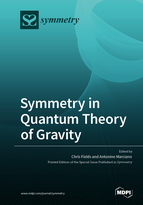Symmetry in Quantum Theory of Gravity
A special issue of Symmetry (ISSN 2073-8994). This special issue belongs to the section "Physics".
Deadline for manuscript submissions: closed (15 December 2021) | Viewed by 13360
Special Issue Editors
Interests: decoherence; holography; quantum gravity; quantum information
Special Issues, Collections and Topics in MDPI journals
Interests: early cosmology; inflation; dark energy; quantum comsology and quantum gravity; quantum gravity phenomenology
Special Issues, Collections and Topics in MDPI journals
Special Issue Information
Dear Colleagues,
Symmetries are at the origin of modern comprehension of fundamental interactions in physics. Internal symmetries both dictate the dynamics of the degrees of freedom of quantum systems and specify how such systems interact. External symmetries—more precisely, diffeomorphism symmetries—provide strong constraints on physical observables, as accurately confirmed by a plethora of high-precision experiments. Our comprehension of quantum gravity models is thus intertwined with the fate of symmetries at high-energy (Planckian) scales. At the same time, the breakdown of global symmetries in quantum gravity might also lead to stringent phenomenological predictions, with observable implications on the mass spectroscopy of dark matter candidates. The reconceptualization of quantum theory in informational terms suggests, on the other hand, that all classical information, including local values of spacetime curvature, results from breaking a symmetry. This offers an appealing scenario in which the structure of spacetime itself could be emergent via some decoherence process or quantum field condensation.
This Special Issue of Symmetry solicits papers from all relevant theoretical perspectives, including novel approaches to information topology and/or geometry. Topics of interest include but are not limited to discrete symmetries in quantum gravity, breakdown of global symmetries in quantum gravity, hypersurface constraint algebra and canonical quantization of gravity, decoherence mechanisms that record curvature information locally in spacetime, “erasure” of curvature through recoherence, the generation of gravitational waves, renormalization group flow, encoding of curvature information in dark energy, dark matter, or supertranslation or other “soft mode” symmetries, spontaneous symmetry breaking and radiative corrections, and the description of scattering or other processes within spacetime from a quantum-computational perspective.
Submit your paper and select the Journal “Symmetry” and the Special Issue “Symmetry in Quantum Theory of Gravity” via: MDPI submission system. Our papers will be published on a rolling basis and we will be pleased to receive your submission once you have finished it.
Dr. Chris Fields
Prof. Dr. Antonino Marciano
Guest Editors
Manuscript Submission Information
Manuscripts should be submitted online at www.mdpi.com by registering and logging in to this website. Once you are registered, click here to go to the submission form. Manuscripts can be submitted until the deadline. All submissions that pass pre-check are peer-reviewed. Accepted papers will be published continuously in the journal (as soon as accepted) and will be listed together on the special issue website. Research articles, review articles as well as short communications are invited. For planned papers, a title and short abstract (about 100 words) can be sent to the Editorial Office for announcement on this website.
Submitted manuscripts should not have been published previously, nor be under consideration for publication elsewhere (except conference proceedings papers). All manuscripts are thoroughly refereed through a single-blind peer-review process. A guide for authors and other relevant information for submission of manuscripts is available on the Instructions for Authors page. Symmetry is an international peer-reviewed open access monthly journal published by MDPI.
Please visit the Instructions for Authors page before submitting a manuscript. The Article Processing Charge (APC) for publication in this open access journal is 2400 CHF (Swiss Francs). Submitted papers should be well formatted and use good English. Authors may use MDPI's English editing service prior to publication or during author revisions.






